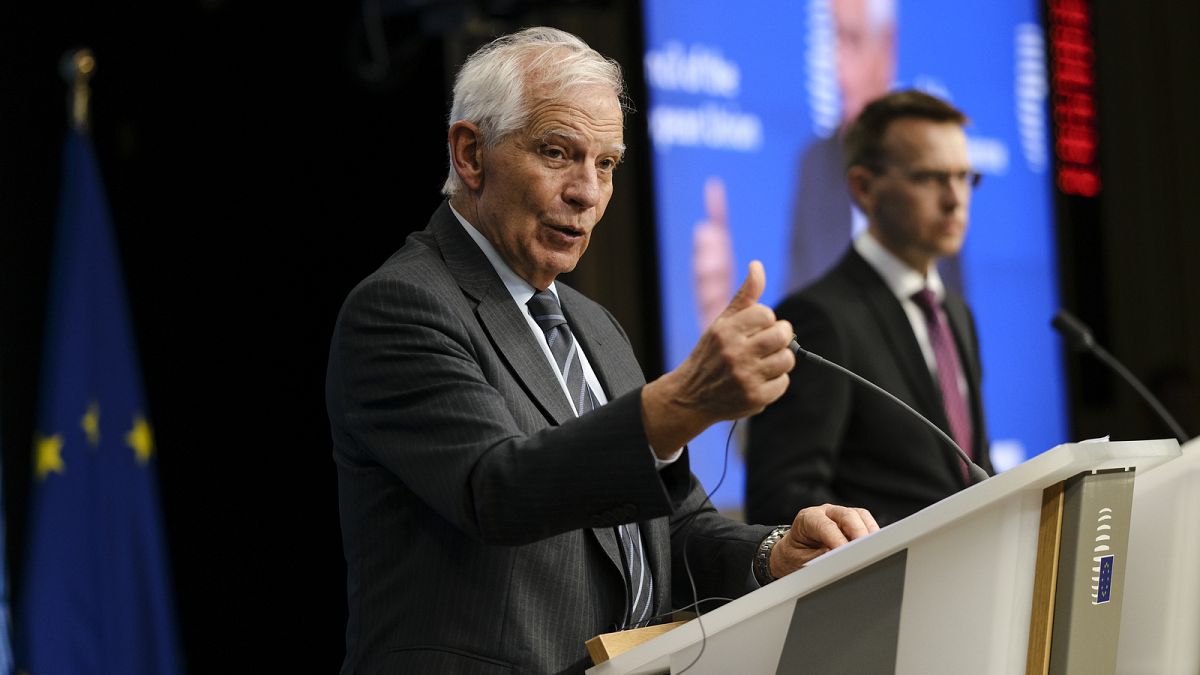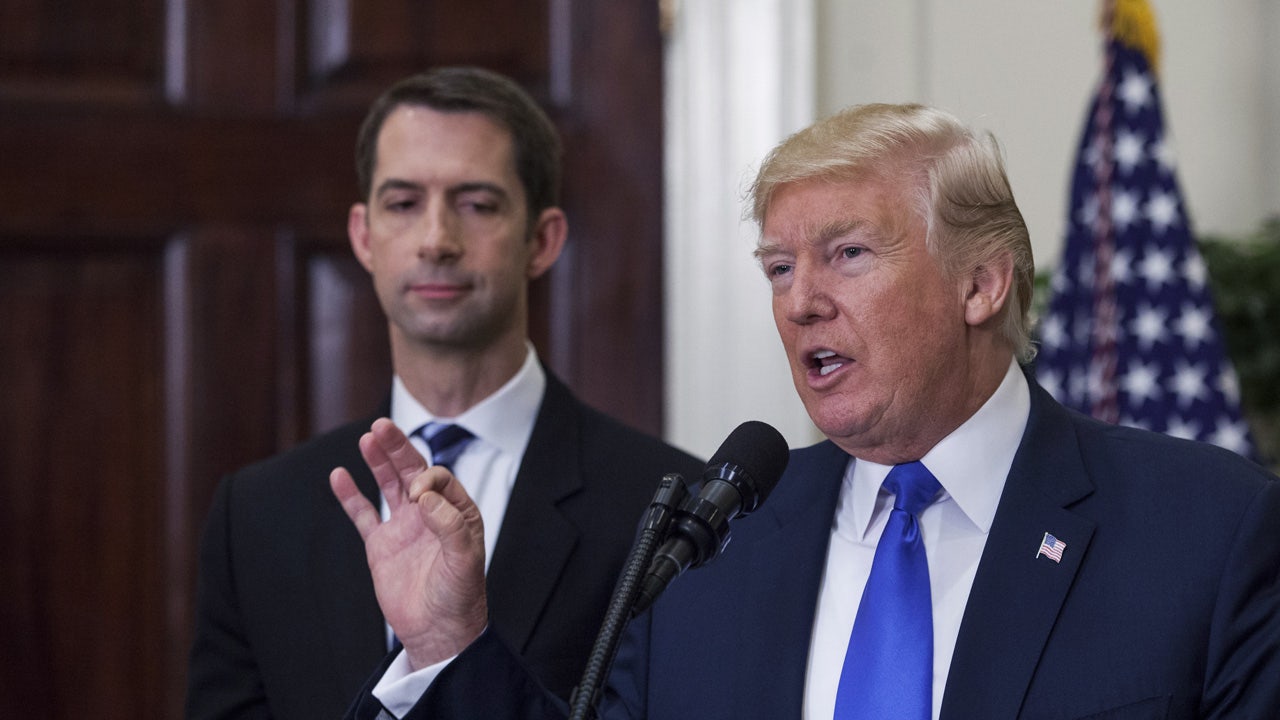Lifestyle
2024 Met Gala Red Carpet: Looks we love

Bad Bunny and Zendaya
Angela Weiss/AFP via Getty Images
hide caption
toggle caption
Angela Weiss/AFP via Getty Images

Bad Bunny and Zendaya
Angela Weiss/AFP via Getty Images
Monday is the Met Gala, a.k.a. fashion’s biggest night, when superstars from across the celebrity stratosphere throng to New York’s Metropolitan Museum of Art to fete fashion – and each other.
This year’s glitzy gala hosts are Zendaya, Jennifer Lopez, Bad Bunny and Chris Hemsworth; the price of a single ticket to the evening is a reported (and eye-watering) $75,000. The guest list is always kept secret — and there’s a no-phones policy once guests step inside the Met’s doors — but past attendees include multi-hyphenate stars like Beyonce, Rihanna and Kim Kardashian.
The gala raises funds for the Met Museum’s Costume Institute. Unlike the rest of the Met’s curatorial areas, the fashion department must pay for itself — and last year, the gala raised some $22 million.

Gigi Hadid.
Theo Wargo/The Hollywood Reporter via Getty
hide caption
toggle caption
Theo Wargo/The Hollywood Reporter via Getty

Actress Gwendoline Christie.
Angela Weiss/AFP via Getty Images
hide caption
toggle caption
Angela Weiss/AFP via Getty Images

Gustav Magnar Witzoe.
Theo Wargo/The Hollywood Reporter via Getty
hide caption
toggle caption
Theo Wargo/The Hollywood Reporter via Getty
Each year’s soiree heralds the opening of a new exhibition at the Costume Institute; this year’s display is called “Sleeping Beauties: Reawakening Fashion.” It features about 250 pieces from the Met’s permanent collection, including garments by Givenchy, Dior and Schiaparelli.
Here are some of the red carpet outfits from tonight:

Zendaya.
Theo Wargo/The Hollywood Reporter via Getty
hide caption
toggle caption
Theo Wargo/The Hollywood Reporter via Getty

Lana Del Rey.
Theo Wargo/GA/The Hollywood Reporter via Getty
hide caption
toggle caption
Theo Wargo/GA/The Hollywood Reporter via Getty

Singer and actress Jennifer Lopez.
Angela Weiss/AFP via Getty Images
hide caption
toggle caption
Angela Weiss/AFP via Getty Images

Demi Moore.
Theo Wargo/GA/The Hollywood Reporter via Getty
hide caption
toggle caption
Theo Wargo/GA/The Hollywood Reporter via Getty

Actor Chris Hemsworth and his wife Spanish model and actress Elsa Pataky.
Angela Weiss/AFP via Getty Images
hide caption
toggle caption
Angela Weiss/AFP via Getty Images

Nicole Kidman.
Theo Wargo/GA/The Hollywood Reporter via Getty
hide caption
toggle caption
Theo Wargo/GA/The Hollywood Reporter via Getty

Karol G.
Theo Wargo/GA/The Hollywood Reporter via Getty
hide caption
toggle caption
Theo Wargo/GA/The Hollywood Reporter via Getty

Ariana Grande and Cynthia Erivo.
Theo Wargo/GA/The Hollywood Reporter via Getty
hide caption
toggle caption
Theo Wargo/GA/The Hollywood Reporter via Getty

Fashion designer Tommy Hilfiger fashion designer Dee Ocleppo Hilfiger.
Angela Weiss/AFP via Getty Images
hide caption
toggle caption
Angela Weiss/AFP via Getty Images

Fashion designer Tommy Hilfiger fashion designer Dee Ocleppo Hilfiger.
Angela Weiss/AFP via Getty Images

Kendall Jenner.
Theo Wargo/GA/The Hollywood Reporter via Getty
hide caption
toggle caption
Theo Wargo/GA/The Hollywood Reporter via Getty

Adrien Brody.
Angela Weiss/AFP via Getty Images
hide caption
toggle caption
Angela Weiss/AFP via Getty Images

Harris Reed.
Theo Wargo/GA/The Hollywood Reporter via Getty
hide caption
toggle caption
Theo Wargo/GA/The Hollywood Reporter via Getty

Serena Williams.
Theo Wargo/GA/The Hollywood Reporter via Getty
hide caption
toggle caption
Theo Wargo/GA/The Hollywood Reporter via Getty

Lena Mahfouf.
Theo Wargo/GA/The Hollywood Reporter via Getty
hide caption
toggle caption
Theo Wargo/GA/The Hollywood Reporter via Getty

Taylor Russell.
Theo Wargo/The Hollywood Reporter via Getty
hide caption
toggle caption
Theo Wargo/The Hollywood Reporter via Getty

Aya Nakamura.
Theo Wargo/GA/The Hollywood Reporter via Getty
hide caption
toggle caption
Theo Wargo/GA/The Hollywood Reporter via Getty

Mindy Kaling.
Theo Wargo/The Hollywood Reporter via Getty
hide caption
toggle caption
Theo Wargo/The Hollywood Reporter via Getty

Sabrina Harrison.
Theo Wargo/The Hollywood Reporter via Getty
hide caption
toggle caption
Theo Wargo/The Hollywood Reporter via Getty

T.V. personality and actress La La Anthony.
Angela Weiss/AFP via Getty Images
hide caption
toggle caption
Angela Weiss/AFP via Getty Images

President of Jujamcyn Theaters, Jordan Roth.
Theo Wargo/The Hollywood Reporter via Getty
hide caption
toggle caption
Theo Wargo/The Hollywood Reporter via Getty

Jessica Biel.
Theo Wargo/GA/The Hollywood Reporter via Getty
hide caption
toggle caption
Theo Wargo/GA/The Hollywood Reporter via Getty

Greta Lee.
Theo Wargo/GA/The Hollywood Reporter via Getty
hide caption
toggle caption
Theo Wargo/GA/The Hollywood Reporter via Getty

Maleah Joi Moon.
Theo Wargo/The Hollywood Reporter via Getty
hide caption
toggle caption
Theo Wargo/The Hollywood Reporter via Getty

Jeff Goldblum.
Theo Wargo/GA/The Hollywood Reporter via Getty
hide caption
toggle caption
Theo Wargo/GA/The Hollywood Reporter via Getty

Bad Bunny.
Theo Wargo/The Hollywood Reporter via Getty
hide caption
toggle caption
Theo Wargo/The Hollywood Reporter via Getty

Wisdom Kay.
Theo Wargo/The Hollywood Reporter via Getty
hide caption
toggle caption
Theo Wargo/The Hollywood Reporter via Getty

Bobby Digi Olisa and Laurie Cumbo.
Theo Wargo/The Hollywood Reporter via Getty
hide caption
toggle caption
Theo Wargo/The Hollywood Reporter via Getty

Rebecca Ferguson.
Theo Wargo/The Hollywood Reporter via Getty
hide caption
toggle caption
Theo Wargo/The Hollywood Reporter via Getty

Model Ashley Graham.
Angela Weiss/AFP via Getty Images
hide caption
toggle caption
Angela Weiss/AFP via Getty Images

Lea Michele.
Theo Wargo/The Hollywood Reporter via Getty
hide caption
toggle caption
Theo Wargo/The Hollywood Reporter via Getty

Lea Michele.
Theo Wargo/The Hollywood Reporter via Getty

Lily James.
Theo Wargo/The Hollywood Reporter via Getty
hide caption
toggle caption
Theo Wargo/The Hollywood Reporter via Getty

Alton Mason.
Theo Wargo/The Hollywood Reporter via Getty
hide caption
toggle caption
Theo Wargo/The Hollywood Reporter via Getty

Social media personality Emma Chamberlain.
Angela Weiss/AFP via Getty Images
hide caption
toggle caption
Angela Weiss/AFP via Getty Images

Lifestyle
What’s better for the climate: A paper book, or an e-reader?
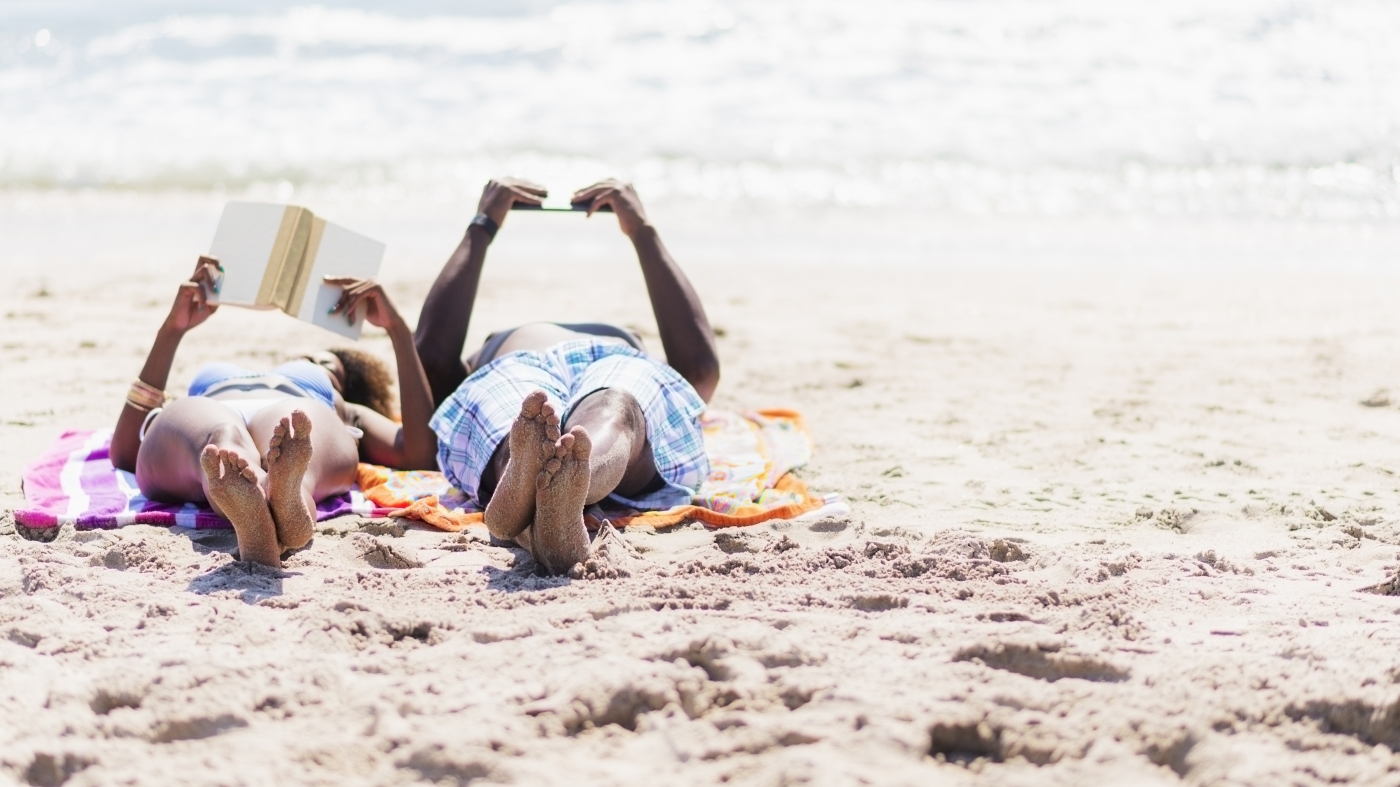
In the face of human-caused climate change, paperbacks and e-readers each have pros and cons.
JGI/Daniel Grill/Getty Images
hide caption
toggle caption
JGI/Daniel Grill/Getty Images
The summer reading season is here.
Some people will opt for paperbacks because they’re easy to borrow and share. Others will go for e-readers, or audiobooks streamed on a phone.
But which is the more environmentally sustainable option? Reading’s carbon footprint is not large compared to other things people do, like travel, and it isn’t something most people consider when choosing how to read a book. But for those looking for small changes in their lives to reduce their impact on the climate, it might be worth exploring how the ways we choose to read books affect the planet.
A complicated question to answer
Whether it’s better to read books in print or on a device is complicated, because of the complex interplay of the resources involved across the entire lifecycle of a published work: how books and devices are shipped, what energy they use to run, if they can be recycled.
Digital reading is on the rise — especially audiobooks. According to the Association of American Publishers, they now capture about the same share of the total US book market as e-books — roughly 15%. But print is still by far the most popular format.

“Publishers are interested in preserving the business that they’ve created over hundreds of years,” said Publishers Weekly executive editor Andrew Albanese, explaining why the industry is focusing most of its efforts on improving the sustainability of paperback and hardcover books, rather than digital formats. “They are looking to run those print book businesses as efficiently as possible, as cleanly as possible, as green as possible.”
On the one side: traditional book publishing
Traditional print publishing comes with a high carbon footprint.
According to 2023 data from the literary industry research group WordsRated, when it comes to pulp and paper, print book publishing is the world’s third-largest industrial greenhouse gas emitter, and 32 million trees are felled each year in the United States to make paper for books. Then there’s the printing and shipping — to say nothing of the many books that are destroyed because they remain unsold.
Although it’s standard practice in the industry, publishers don’t want to destroy books. So instead, many are donating unsold copies, switching to on-demand printing, or, like Chronicle Books, are reducing their initial print runs to see how well the titles sell before they print more.
“We felt that it was better to have a higher cost and have less waste,” said Chronicle Books president, Tyrrell Mahoney.
Chronicle Books, like many other publishers, is also trying to use more sustainable paper.
“We have this great partner in India who has now figured out how to use cotton-based up-cycled materials to print as paper,” Mahoney said.
Publishers are also rethinking book design. It might be a surprise, but certain fonts can be more climate-friendly by using less ink and less paper.

Harper Collins has introduced sustainable fonts that use less ink.
Harper Collins/Harper Collins
hide caption
toggle caption
Harper Collins/Harper Collins
“So far, these subtle, imperceptible tweaks have saved more than 200 million pages across 227 titles since September,” said Harper Collins’ senior director of design Lucy Albanese. NPR could not independently verify these page savings.
On the other: digital publishing
All well and good. But digital reading seems to have a considerable eco-advantage over print because it is paperless, so it saves trees, pulping and shipping. Moreover, tech companies that make e-readers such as Amazon, which sells the market-leading Kindle e-reader, offer recycling programs for old devices.

“By choosing e-books as an alternative to print, Kindle readers helped save an estimated 2.3 million metric tons of carbon emissions over a two year period,” said Corey Badcock, head of Kindle product and marketing. NPR could not independently verify these emissions reductions.
But digital devices also come with a substantial carbon footprint, predominantly at the manufacturing stage. Their cases are made with fossil-fuel-derived plastics and the minerals in their batteries require resource-heavy mining.
The short answer to which is better: it depends
“It’s not cut and dried,” said Mike Berners-Lee, a professor of sustainability at Lancaster Environment Centre in the United Kingdom, of the comparative climate friendliness of digital versus print reading.
Berners-Lee, the author of The Carbon Footprint of Everything, said the average e-reader has a carbon footprint of around 80 pounds.
“This means that I’ve got to read about 36 small paperback books-worth on it before you break even,” he said.

Figuring out whether to take a digital device or a paperback to the beach ultimately depends on how voraciously you read.
“If you buy an e-reader and you read loads and loads of books on it, then it’s the lowest carbon thing to do,” Berners-Lee said. “But if I buy it, read a couple of books, and decided that I prefer paperback books, then it’s the worst of all worlds.”
Yet Berners-Lee said that reading is still, relatively speaking, a pretty sustainable activity — regardless of whether you read using an e-reader, phone or old-fashioned paperback.
Both audio and digital versions of this story were edited by Jennifer Vanasco. Isabella Gomez-Sarmiento mixed the audio version.
Lifestyle
They transformed a sad, junk-filled yard into a DIY native plant wonderland

Water-hungry lawns are symbols of Los Angeles’ past. In this series, we spotlight yards with alternative, low-water landscaping built for the future.
At the top of a roller-coaster hill in Highland Park, Thomas Zamora and his husband, Raul Rojas, enjoy two spectacular views — of the Pasadena hills to the east and of the meandering expanse of native plants, succulents and vegetables in a backyard that once was nothing but dirt and junk cars.
It’s been an evolution of nearly a decade, say Zamora and Rojas, but today, their backyard boasts a deck rimmed with pots of colorful succulents and wide water-permeable paths of flagstone and river pebbles, lined with fragrant plantings of California native trees and flowering shrubs. There’s a raised bed full of vegetables, a potted lemon tree and a few red-blooming Australian grevilleas and South African leucadendron left over from the early days of their landscaping journey “because the hummingbirds love them so much,” Zamora said. “They fight over the flowers, so we couldn’t stand to take them out.”
But almost everything else in the backyard, along with the terraced planters out front and the parkway, is devoted to California native plants, a passion inspired by the Theodore Payne Foundation’s Native Plant Garden Tour in 2015, when the couple saw what beautiful gardens others had created from native perennials, shrubs and wildflowers.
An oasis of welcoming serenity in the backyard of Raul Rojas and Thomas Zamora’s Highland Park home.
“That started us on our journey of ‘Frankensteining’ our landscape,” Zamora said, laughing. “The tours helped us get ideas for what elements we thought would look great in our yard. It wasn’t a formal process, because we did things ourselves. We found things we wanted, and places to fit them in, and just sort of winged it.”
They winged it so well that their home is now a regular part of Theodore Payne’s Native Plant Garden Tour, being held on April 13 and 14 this year. (Tickets are sold out online, but at publication time were still available for purchase in person at the foundation’s office in Sun Valley, Tuesdays through Saturdays from 8:30 a.m. to 4:30 p.m. for $55 (children under 16 are free).
The couple’s garden is alive with bees, hummingbirds and other pollinators, and there are chairs and even a flower-shaded bench for visitors to sit and admire the view. The space exudes serenity and invites wanderers —and is clearly a labor of love for both Zamora and Rojas. “Every Sunday is garden day and we enjoy the process,” Rojas said. “It’s a place for exercise and meditation … our happy place. And who does the weeding? Us!”
On their tidy potting bench, a butter knife rests in a pot, at the ready to tackle any unwanted sprouts. “The best weeding tool is a butter knife,” Rojas says confidentially. “My grandma taught me that; you just jab the knife in at the base of the root and pull the weed up by pinching it between two fingers.”
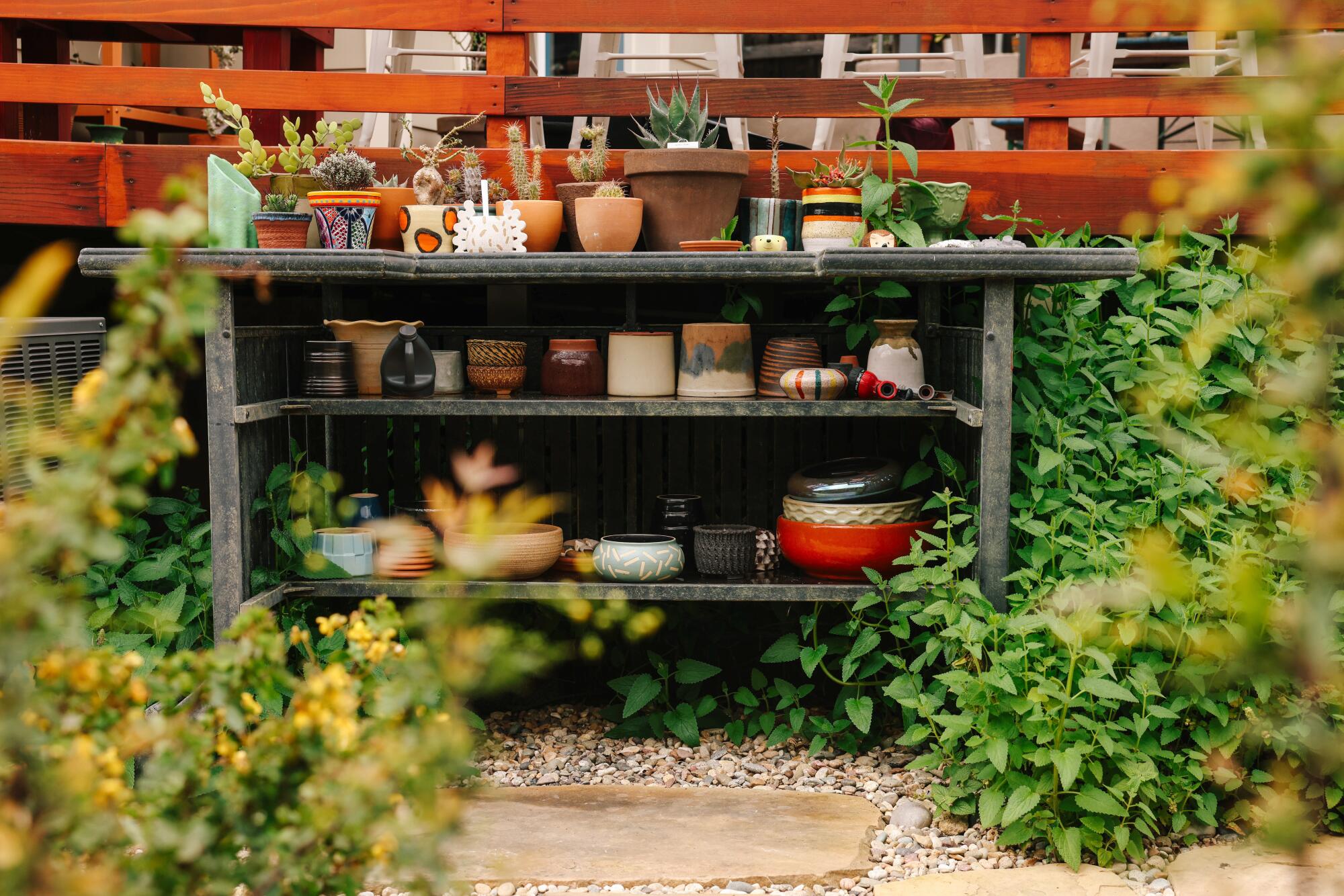
A relative’s discarded outdoor bar became the perfect potting bench for the couple’s backyard.
Clearly the technique works, because weeds — the bane of most gardens, including native plant landscapes — are visible nowhere in this yard. The plantings are jumbled but meticulous — almost Disney-esque — with brimming pots of succulents on the front porch and overflowing terraces of blue-blooming rosemary, a Mediterranean plant, along with native plants like evergreen currant (Ribes viburnifolium), island alum root (Heuchera maxima), fragrant blue pitcher sage (Lepechinia fragrans), bush sunflowers (Encelia californica) and island buckwheat hybrid (Eriogonum x blissianum)
It all looks perfect, down to the beautiful tangle of poppies and other native wildflowers in the narrow strip of parkway. But the process offered plenty of challenges, Zamora and Rojas said. “We’ve learned a lot along the way,” Rojas said.
Both men are California natives whose families enjoyed gardening and being outdoors, but they grew up around more traditional plants like roses, fruit trees and succulents. Plus, Rojas laughed, his parents kept him busy pulling weeds as a child.
When Zamora, an art department coordinator for TV shows like “No Good Deed,” bought the 1923 bungalow in 2009, the smallish backyard was filled with hard dirt and three junk cars, which thankfully were removed before he moved in in 2010. In the beginning, before he met Rojas, he focused more on the interior of the house and dabbled at planting just a few flower beds outside. He said his focus then was on showy drought-tolerant plants like statice and Pride of Madeira, a fast-growing perennial with giant purple blooms native to the Portuguese island of Madeira.
1

2
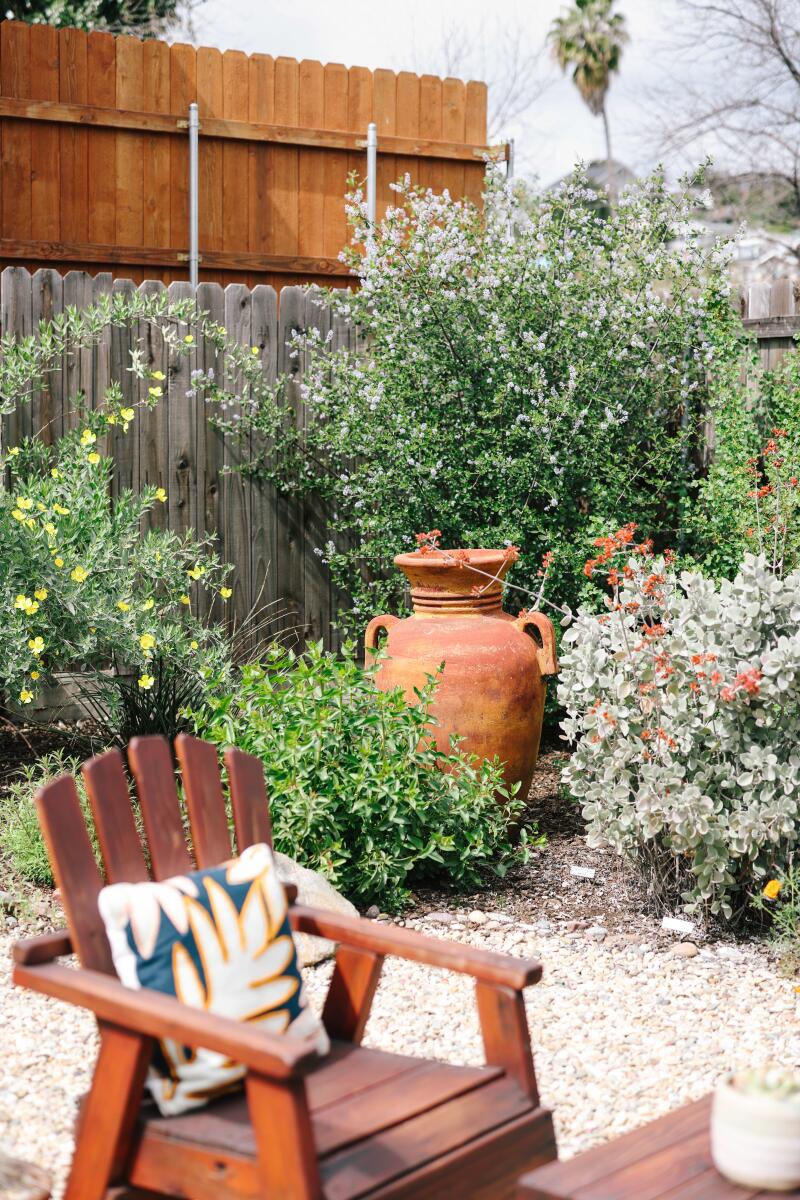
1. A leucadendron “Jester” from South Africa grows against a neighbor’s garage wall, against an artistic display of paint cans. The leucadendron is a holdover from Zamora’s earliest landscaping attempts, kept because it’s so popular with the hummingbirds. 2. (Dania Maxwell/Los Angeles Times)
“I didn’t realize these plants are invasive along the central coast,” he said. “I was just planting things because they looked pretty, and I knew they would grow because I’d seen them in other places.”
He added the leucadendron and grevillea for their showstopping, drought-tolerant blooms. But he also planted a white sage (Salvia apiana) because he admired the silvery green foliage of one of Southern California’s most famous indigenous plants during a local hike.
After Rojas moved in in 2012, the couple got more serious about the yard, visiting plant stores and nurseries to get ideas. In 2015, during a visit to Potted in Atwater Village, they saw a flier for the Theodore Payne tour and decided to give it try. It was easy to buy tickets for the tour in those days, Rojas said — “They didn’t sell out like they do today” — and the gardens they saw finally gave their landscaping a sharp focus: native plants.
“It was one of the best decisions we ever made,” Zamora said.
But once they started adding native plants in earnest, the challenges started. They amended their heavy clay soil with compost and other additives, something you would normally do to plant traditional landscape ornamentals and food. But after many of the new plants died, they learned their yard had mostly heavy, slow-draining clay soil, and that native plants prefer well-draining native soils over enriched garden plots.
“I learned that from one of Theodore Payne’s ‘Right Plant, Right Place’ classes that teaches you what plants do best in your situation,” Zamora said. “And I also used Calscape to find out if the plants I’m interested in will tolerate clay soils. That’s how we figured out a plan for adding plants we would love to have but don’t have a place where they will work.”
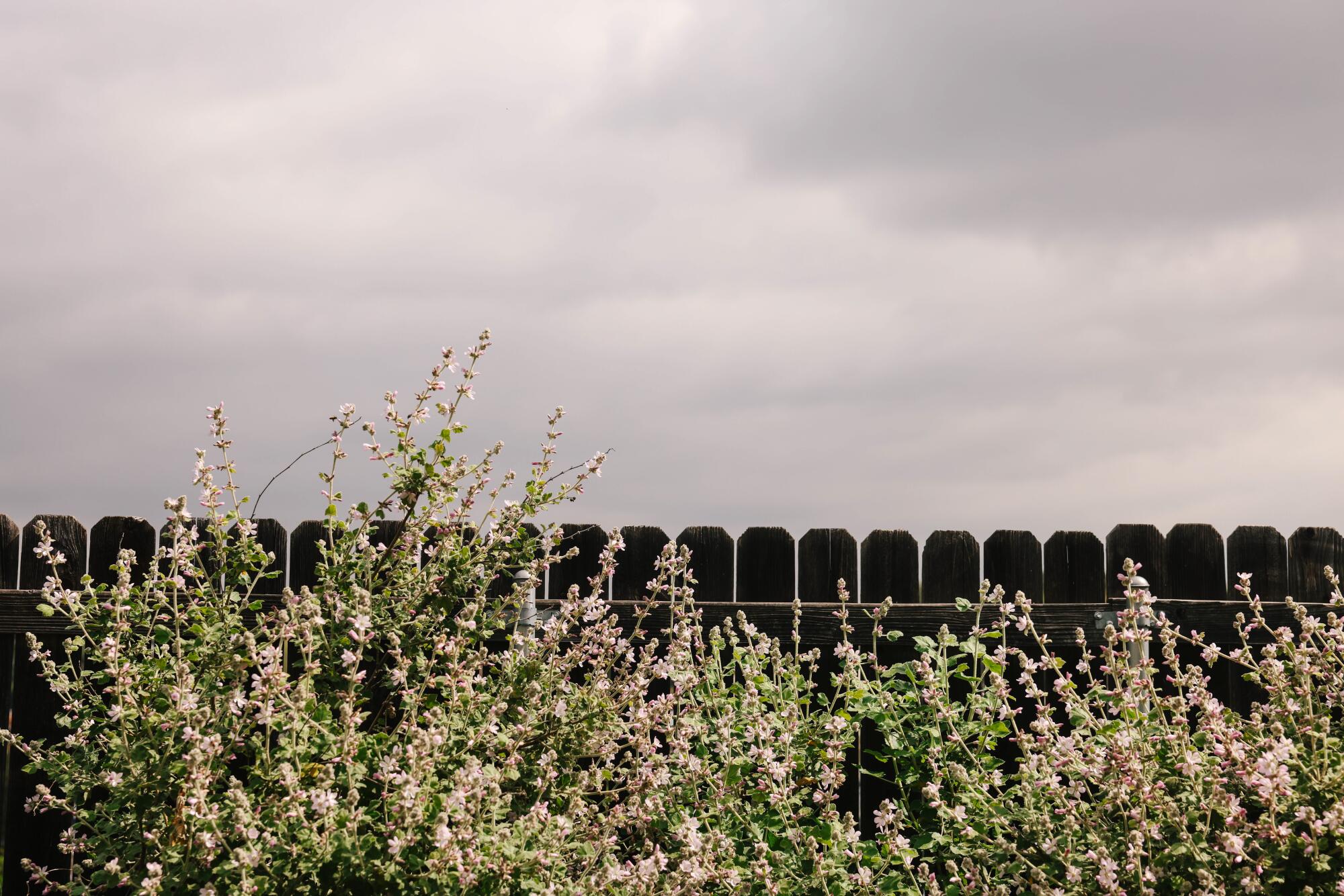
A San Clemente Island bushmallow loaded with pink blooms was planted from a one-gallon container and now grows exuberantly along the east fence of Raul Rojas and Thomas Zamora’s backyard.
They grow plants that don’t like clay in pots, such as the super-sweet smelling woolly bluecurls (Trichostema lanatum) near their side door; once established, it’s easily killed by too much water. The white sage has thrived, along with a very happy San Clemente Island bushmallow (Malacothamnus clementinus) that has grown from a one-gallon container to a massive shrub covered with blooms along their east fence.
They never really had a formal design, Zamora said. They tried things, and if it didn’t work, they tried something else. Initially they added two raised beds for vegetables but eventually removed one to create more space for paths and native plantings.
Adding pebble walkways helped solve problems with runoff and standing water in the backyard. “We do not have a bioswale [to capture rainwater until it drains into the soil] — I wish I had known about those when I was doing the walks,” Zamora said. “But I leveled the area so the water doesn’t pool now, and the rocks seem to help hold water so it doesn’t run off; it just seeps into the ground through the pavers.”
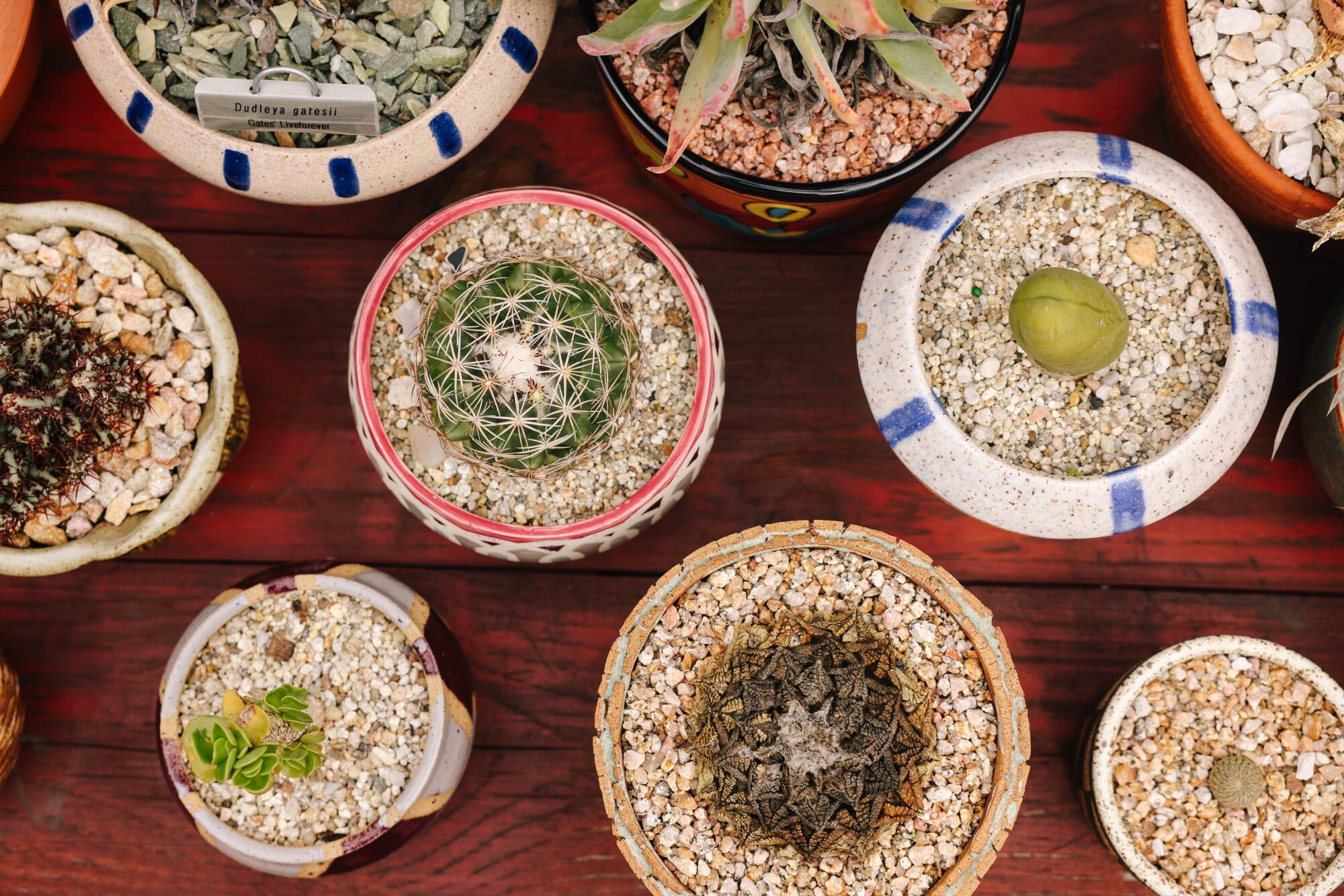
Succulents in colorful pots line the deck, front porch and potting bench at the home of Raul Rojas and Thomas Zamora.
Another helpful resource has been regular visits to the California Botanic Garden in Claremont, the state’s largest botanic garden devoted entirely to native plants. “It’s a peaceful place and very inspiring to see plants in their habitat,” Zamora said. “We went there lots during the pandemic because it was such a great place to walk around.”
They’re also regular customers of Hardy Californians, a pop-up native plant nursery in Sierra Madre. Rojas, an entertainment publicist, even volunteered there during the Hollywood actors’ strike in 2023, and came away an even bigger convert to the versatility and beauty of native plants.
“Our neighbors have been very positive,” Rojas said. “We got little signs for all the plants because people on neighborhood walks always ask us what we’ve planted, and what we recommend for a specific situation.”
A large ficus tree in the parkway outside their front door has died, probably because of damage when the street was dug up for water-pipe repairs. It’s a city-owned tree, Zamora said, so a city crew will have to remove it, “but we’re definitely going to talk to them about replacing it with something native.”
Over the years, they’ve gotten much more sanguine about the circle of life in their garden. “We’ve learned that gardening is a process and some plants do better than others,” Rojas said. “We used to get so upset — ‘OMG, this died!’ — but at this point, it’s more like, ‘Oh, this didn’t like that location.’ Now we see it as just a new planting opportunity.”
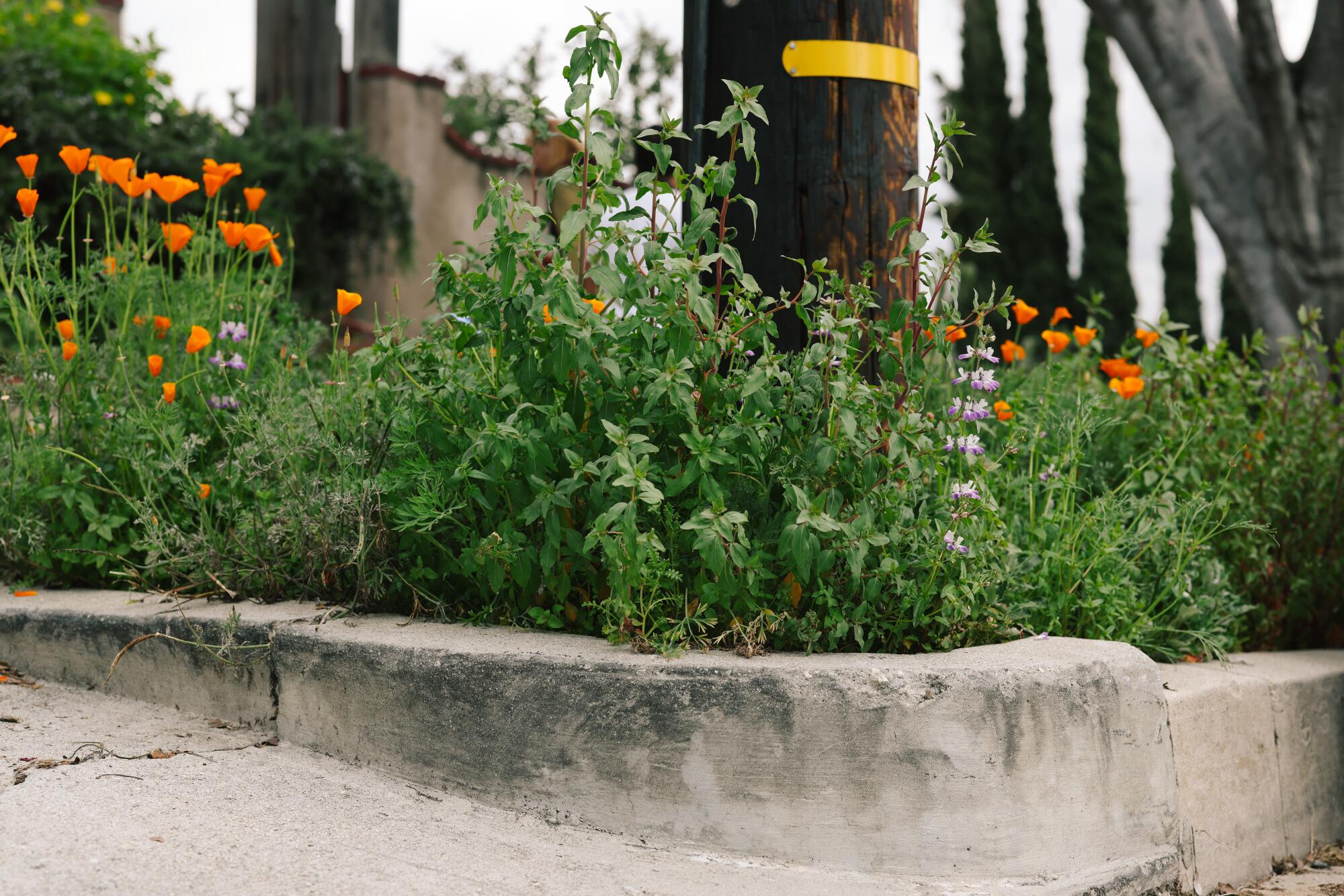
California poppies (Eschscholzia californica), purple Chinese houses (Collinsia heterophylla), baby blue eyes
(Nemophila menziesii) and other wildflowers grow thickly in the narrow parkway outside their home.
Lifestyle
'Anora' wins Palme d'Or at the 77th Cannes Film Festival
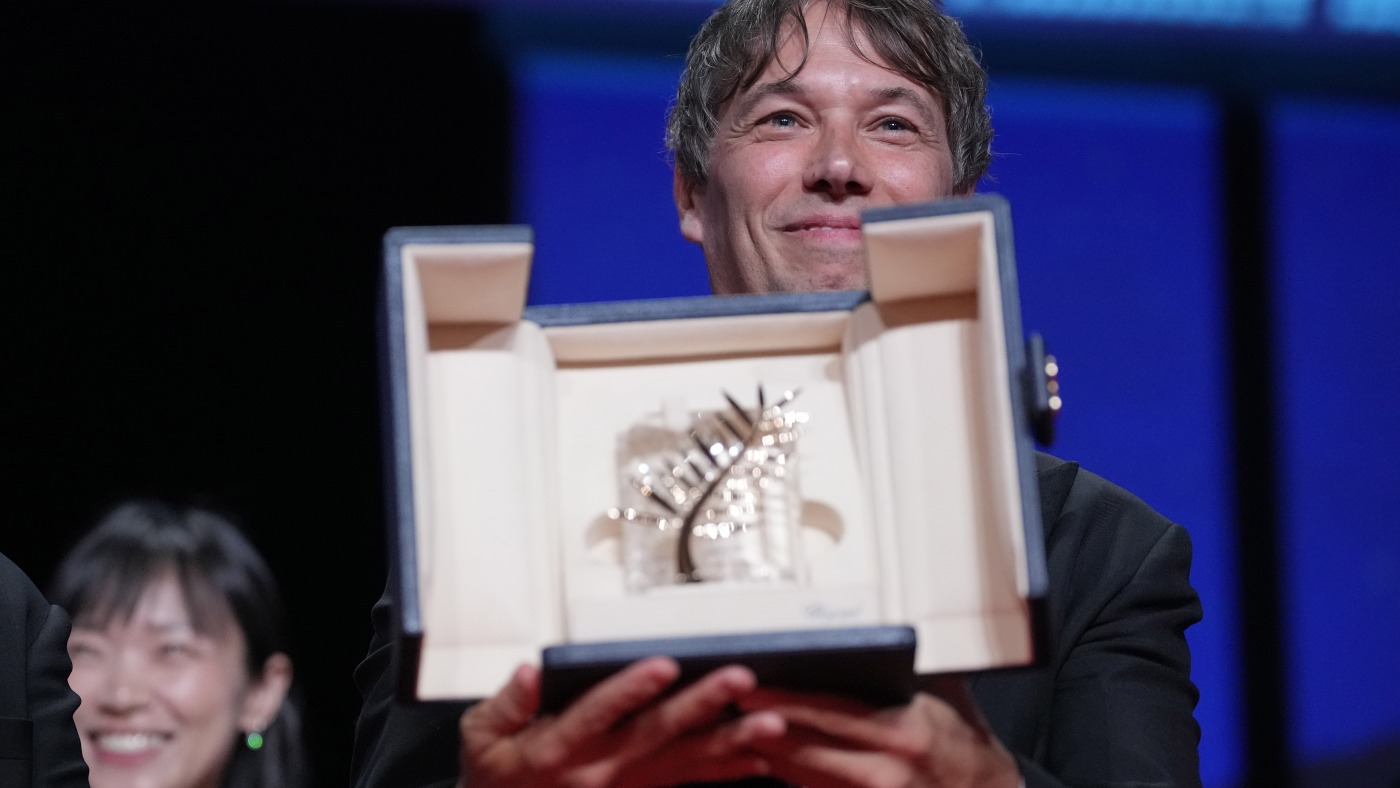
Sean Baker holds the Palme d’Or for the film Anora, during the awards ceremony of the 77th international film festival in Cannes, southern France, on Saturday.
Andreea Alexandru/Invision/AP
hide caption
toggle caption
Andreea Alexandru/Invision/AP
The 77th Cannes Film Festival drew to a close on Saturday at the French Riviera city’s Grand Théâtre Lumière, with Anora snatching the festival’s top prize, the Palme d’Or.
Sean Baker’s dramedy, starring Mikey Madison (Better Things, One Upon A Time In Hollywood), tells the story of a New York stripper who gets more than she bargained for when she marries the son of a Russian oligarch.
Baker is the first U.S. filmmaker to win the Palme d’Or since Terrence Malick, who won it for The Tree of Life in 2011.
When accepting his award, Baker spoke from the podium about the importance of the moviegoing experience. “Watching a film with others in a movie theater is one of the great communal experiences,” Baker said. “We share laughter, sorrow, anger, fear and hopefully have a catharsis with our friends and strangers. So I say the future of cinema is where it started: in a movie theater.”
Last year’s winner of the prestigious award was Justine Triet’s Anatomy of a Fall starring Sandra Hüller.
Barbie director Greta Gerwig headed up the main jury, which also included Killers of the Flower Moon actor Lily Gladstone. The jury selected winners from a pool of 22 films in the main competition.

Jury president Greta Gerwig at the awards ceremony of the 77th international film festival in Cannes, southern France, on Saturday.
Andreea Alexandru/Invision/AP
hide caption
toggle caption
Andreea Alexandru/Invision/AP
“I will be forever changed, I think, as a filmmaker because of this experience,” Gerwig said at the jury’s closing press conference.
“I was so lucky to be with this group of artists,” said Gladstone. “We didn’t always agree. I learned from the alternate points of view.”
Award winners
Honors also went to Miguel Gomes, who won the best director award for Grand Tour; the all-female acting ensemble from the musical comedy Emilia Pérez took the best actress award — Adriana Paz, Zoe Saldana, Karla Sofía Gascón and Selena Gomez; the best actor accolade went to Jesse Plemons for Kinds of Kindness; and Coralie Fargeat won best screenplay for The Substance.
Emilia Pérez also won the jury prize; All We Imagine as Light was the winner of the grand prize; the Camera d’Or prize for best first film was won by the movie Armand, directed by Halfdan Ullmann Tøndel; Nebojša Slijepčević won the Short Film Palme d’Or for The Man Who Could Not Remain Silent; and the special prize was awarded to Mohammad Rasoulof for The Seed of the Sacred Fig.
A shadow was cast over this year’s event after the Iranian government charged Rasoulof with creating propaganda against the regime shortly after Cannes selected his film for this year’s competition. The thriller focuses on a judge in Tehran’s Revolutionary Court who deals with paranoia amid intense political protests. The director was sentenced to eight years behind bars, as well as flogging and a fine.
The cast and crew were interrogated. Rasoulof was pressured to withdraw his movie, but managed to escape to Germany. Rasoulof was present for the film’s world premiere screening on Friday. The film received a 12-minute standing ovation. U.S. distributor Neon bought the North American rights.
The festival also awarded a trio of Honorary Palme d’Ors this year — to actress Meryl Streep, Japanese animation powerhouse Studio Ghibli and producer-director George Lucas.
-

 Movie Reviews1 week ago
Movie Reviews1 week ago‘The Substance’ Review: An Excellent Demi Moore Helps Sustain Coralie Fargeat’s Stylish but Redundant Body Horror
-

 Politics1 week ago
Politics1 week agoTrump predicts 'jacked up' Biden at upcoming debates, blasts Bidenomics in battleground speech
-

 World1 week ago
World1 week agoIndia’s biggest election prize: Can the Gandhi family survive Modi?
-

 Finance1 week ago
Finance1 week agoSan Bernardino finance director claims she was fired after raising concerns about costly project
-

 News1 week ago
News1 week agoVideo: A Student Protester Facing Disciplinary Action Has ‘No Regrets’
-

 World1 week ago
World1 week agoPanic in Bishkek: Why were Pakistani students attacked in Kyrgyzstan?
-

 Movie Reviews1 week ago
Movie Reviews1 week ago‘Rumours’ Review: Cate Blanchett and Alicia Vikander Play Clueless World Leaders in Guy Maddin’s Very Funny, Truly Silly Dark Comedy
-

 Movie Reviews1 week ago
Movie Reviews1 week ago‘Blue Sun Palace’ Review: An Intimate, Affecting and Dogma-Free Portrait of Chinese Immigrants in Working-Class New York












